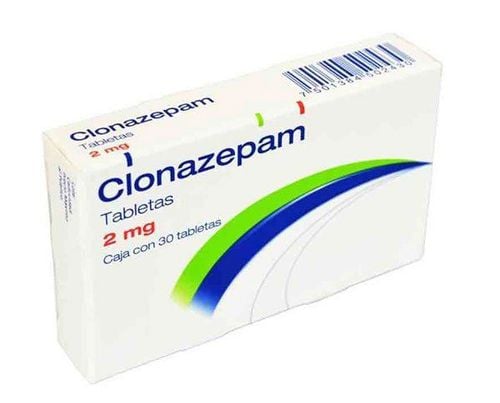This is an automatically translated article.
Alzocalm 0.5 and 1.0 belong to the group of anticonvulsants, indicated for the treatment of epilepsy in adults and children. So how is Alzocalm used? The following article will provide necessary information for drug users to ensure effectiveness and safety.
1. What are Alzocalm 0.5 and 1.0 drugs?
Alzocalm 0.5 and 1.0 contain the ingredient Clonazepam, depending on the content of the active ingredient in the drug, respectively 0.5mg, 1mg and the excipients are just enough provided by the manufacturer. The drug is prepared in the form of tablets, packing box of 10 blisters, each blister of 10 tablets or a bottle of 100 tablets.
2. What are the effects of Alzocalm?
Alzocalm 0.5 and 1.0 are indicated for the treatment of the following cases:
Epilepsy : Treatment of all types of epilepsy and convulsions, especially for typical or atypical micro-epileptic seizures. Panic disorder: Treatment of panic attacks, with or without claustrophobia and agoraphobia. Alzocalm 0.5 and 1.0 are contraindicated for use in patients as follows:
Allergy to the active ingredient Clonazepam or other excipients in the composition of the drug. History of allergy to benzodiazepines. Disease associated with impaired liver function (hepatitis, cirrhosis) or glaucoma.
3. Dosage and how to use Alzocalm 0.5 and 1.0
Alzocalm 0.5 and 1.0 are prepared in the form of tablets, administered orally.
The following is the recommended dose of Alzocalm:
In the treatment of epilepsy:
Adults:
The starting dose is 1mg (for the elderly is 0.5mg), do not exceed the maximum dose for Allowance is 1.5mg per day, divided into 3 doses. Dosage may be increased by 0.5 to 1 mg every 3 days until seizures are controlled or when undesirable effects occur that prevent an increase in the patient's dose. The maintenance dose ranges from 4 to 8 mg per day, divided into 3 doses depending on the response of each patient. The maximum dose is 20mg/day. Breastfeeding children and children (under 10 years old or weighing less than 30kg):
The starting dose is from 0.01 to 0.03mg/kg/day, divided into 3 doses. Every 3 days, the dose may be increased by no more than 0.25 - 0.5 mg/kg/day to a maintenance dose of 0.1 - 0.2 mg/kg/day, divided into 3 doses. The maximum dose is 0.2mg/kg/day. In the treatment of panic disorder:
Adults:
The starting dose is 0.25 mg/time, administered twice daily. The dose may be increased up to 1mg/day, after 3 days of dosing. When stopping treatment, the dose must be reduced gradually, in 3 days reduce 0.125 mg until stopping the drug. Breastfeeding infants and children:
There is insufficient clinical experience with Alzocalm 0.5 and 1 in the treatment of panic disorder in patients under 1 year of age. Note: The above dosage is for reference only, the treating doctor will base on the condition of each patient to determine the appropriate dosage.
4. Side effects of Alzocalm 0.5 and 1.0
Before prescribing, doctors always weigh the effective benefits that Alzocalm 1.0 and 0.5 bring as well as the possible risks for the patient. However, some cases when taking Alzocalm 0.5 and 1.0 drugs may still occur undesirable effects as follows:
Common:
Drowsiness, coordination disorder, behavior disorder, confusion, decreased ability intellectual capacity, constipation, abdominal pain, dysmenorrhea (found in women). Uncommon:
Anemia, leukopenia/platelet count, respiratory failure. In the process of taking the drug, when the patient encounters the above undesirable effects or any symptoms, immediately notify the doctor for appropriate intervention.
5. Alzocalm 0.5 and 1.0 . drug interactions
In order to avoid interactions that occur when taking a combination of drugs, the patient should tell the doctor about the drugs being used.
The following are some drugs that have the potential to interact with Alzocalm 0.5 and 1.0 when combined:
Phenytoin, Phenobarbital may increase the metabolism of Alzocalm and decrease the drug plasma concentration. The CNS depressant effect of Alzocalm may be increased when used with alcohol, anesthetics, hypnotics, anxiolytics, antipsychotics, monoamine inhibitors and other anticonvulsants. . Use caution with oral antifungal agents when combined with Alzocalm 0.5 and 1.0.
6. Some notes when using Alzocalm 0.5 and 1.0
Here are some notes when taking Alzocalm 0.5 and 1.0 to help achieve effective treatment as well as reduce the risk of side effects:
Stop taking Alzocalm 0.5 and 1.0 suddenly, especially in patients undergoing treatment. Long-term high-dose drug therapy can cause status epilepticus, withdrawal symptoms such as convulsions, psychosis, hallucinations, behavioral disturbances, tremors, and muscle and abdominal cramps. Therefore, discontinuation of the drug must be gradual and at the same time an alternative anticonvulsant may be indicated. Long-term use of the drug can lead to the risk of drug dependence. Concomitant use of both Valproic acid and Alzocalm 0.5, 1.0 may cause the appearance of absence seizures. Pregnant and lactating women: Do not use this drug for this group of people. Breast-feeding may be discontinued when this drug is administered to breast-feeding mothers. Use caution when using this drug in subjects who drive or operate machinery because of the possible side effects of the drug. When overdosing Alzocalm 0.5 and 1.0, patients often experience symptoms such as somnolence, confusion, coma, decreased reflexes. Respiratory, pulse and blood pressure should be monitored, supportive measures taken, gastric lavage as soon as possible. An intravenous line should be placed to administer intravenous fluids and ensure good ventilation for the patient. If the patient has low blood pressure, use levarterenol. Above is the important information of Alzocalm, carefully reading the instructions before use and strictly following the doctor's instructions will help patients use the drug effectively and safely.
Please dial HOTLINE for more information or register for an appointment HERE. Download MyVinmec app to make appointments faster and to manage your bookings easily.













